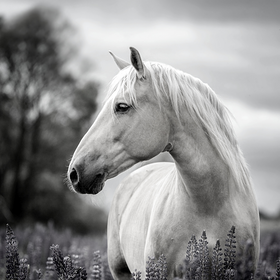
Understanding Thrush in Horses: Causes, Symptoms & Remedies
Understanding Thrush in Horses: Causes, Symptoms & Remedies
If you've spent any time around horses, chances are you've encountered—or at least heard of—thrush. This common hoof condition can sneak up quietly but cause discomfort, lameness, and long-term hoof issues if not addressed promptly. Let's break down what thrush is, what causes it, and most importantly, how to treat and prevent it.
What is Thrush?
Thrush is a bacterial infection that affects the frog of the horse's hoof, particularly thriving in the central sulcus and collateral grooves (the crevices around the frog). It’s typically characterized by a black, foul-smelling discharge and deterioration of the frog tissue. Left untreated, it can penetrate deeper, causing sensitivity, pain, and even lameness.
What Causes Thrush?
Thrush is caused by anaerobic bacteria, most commonly Fusobacterium necrophorum, which thrive in wet, dirty, and poorly ventilated conditions. However, it's not just about a mucky paddock—several factors can contribute:
-
Poor hoof hygiene: Buildup of manure, urine, and wet bedding can create the perfect environment for thrush.
-
Lack of exercise: Horses that are stalled for long periods without turnout may have reduced circulation in their hooves and less natural cleaning from movement.
-
Unbalanced hoof trimming: Deep sulci or contracted heels can trap bacteria and moisture.
-
Compromised immune system: Some horses are more susceptible due to overall health or diet issues.
What are the Signs and Symptoms
A strong, foul odor coming from the hoof, usually a black, tar-like discharge around the frog with crumbly or decayed frog tissue. Many horses have sensitivity or pain when their feet are being picked. In more advanced cases, lameness or heat in the hoof.
Remedies & Treatment for Thrush
Thankfully, early intervention and consistent care can resolve most cases of thrush.
1. Clean the hoof thoroughly.
Start by picking out the hoof daily, especially after being in wet or dirty conditions. Use a stiff brush to scrub the frog and grooves with warm water or an antiseptic solution like Betadine or Chlorhexidine.
2. Topical Treatments
Apply a thrush treatment product once or twice daily, depending on severity. Some popular remedies include:
Thrushbuster, Tomorrow Dry Cow Treatment (off-label, but effective), Copper sulfate-based solutions and tea tree oil or iodine mixtures
Natural options like apple cider vinegar or a mixture of sugar and iodine can also work in milder cases.
3. Keep the Environment Dry
Stall hygiene is crucial. Clean bedding regularly, and avoid excessive moisture. If the paddocks are muddy, consider providing dry areas for your horse to stand.
4. Corrective Trimming
A skilled farrier can help open up contracted heels or trim away dead frog tissue to promote air circulation and healing. Regular farrier visits are key to long-term prevention.
5. Diet and Overall Health
Ensure your horse is on a balanced diet, rich in biotin and other hoof-supporting nutrients. A strong immune system can help prevent recurrence.
Preventing Thrush in the Long Run
Preventing thrush starts with a consistent and attentive hoof care routine. Picking out your horse’s hooves daily is one of the simplest yet most effective ways to remove debris and spot early signs of infection. Keeping stalls clean and dry, with regularly changed bedding, helps reduce bacterial growth, especially during wet or muddy seasons. Regular turnout and movement not only promote hoof health through increased circulation but also reduce the time spent standing in potentially unhygienic conditions. Ensuring your horse receives routine trims from a skilled farrier helps maintain proper hoof balance and prevents deep crevices where bacteria can thrive. Lastly, maintaining a balanced diet rich in hoof-supporting nutrients like biotin contributes to strong, resilient hooves and an overall healthier horse. By making these practices part of your everyday routine, you can significantly lower the risk of thrush and support long-term hoof health.
Your horse’s hooves are the foundation of their health—treat them like gold!





